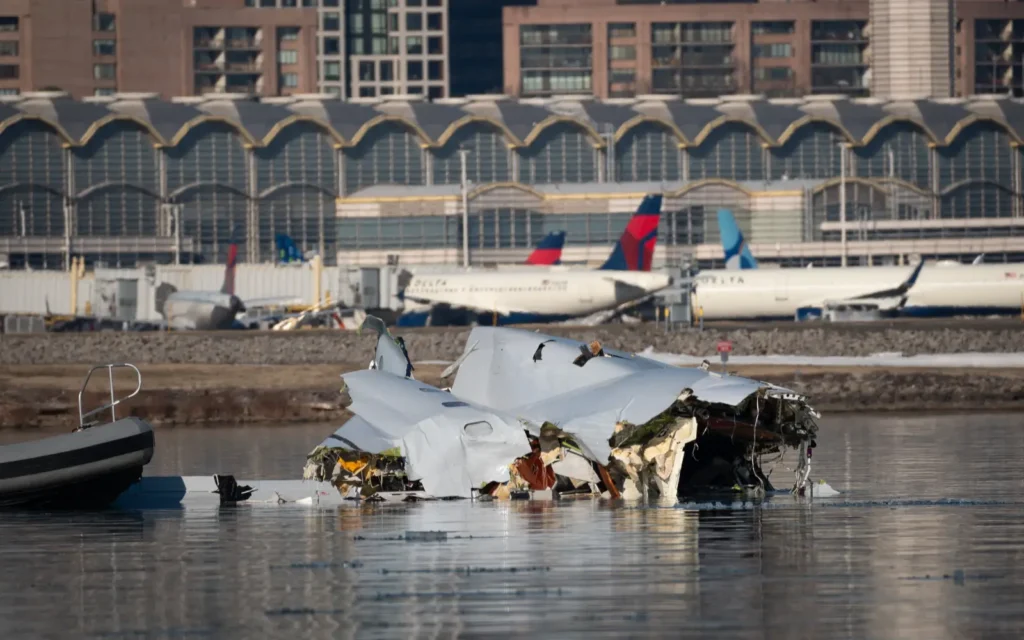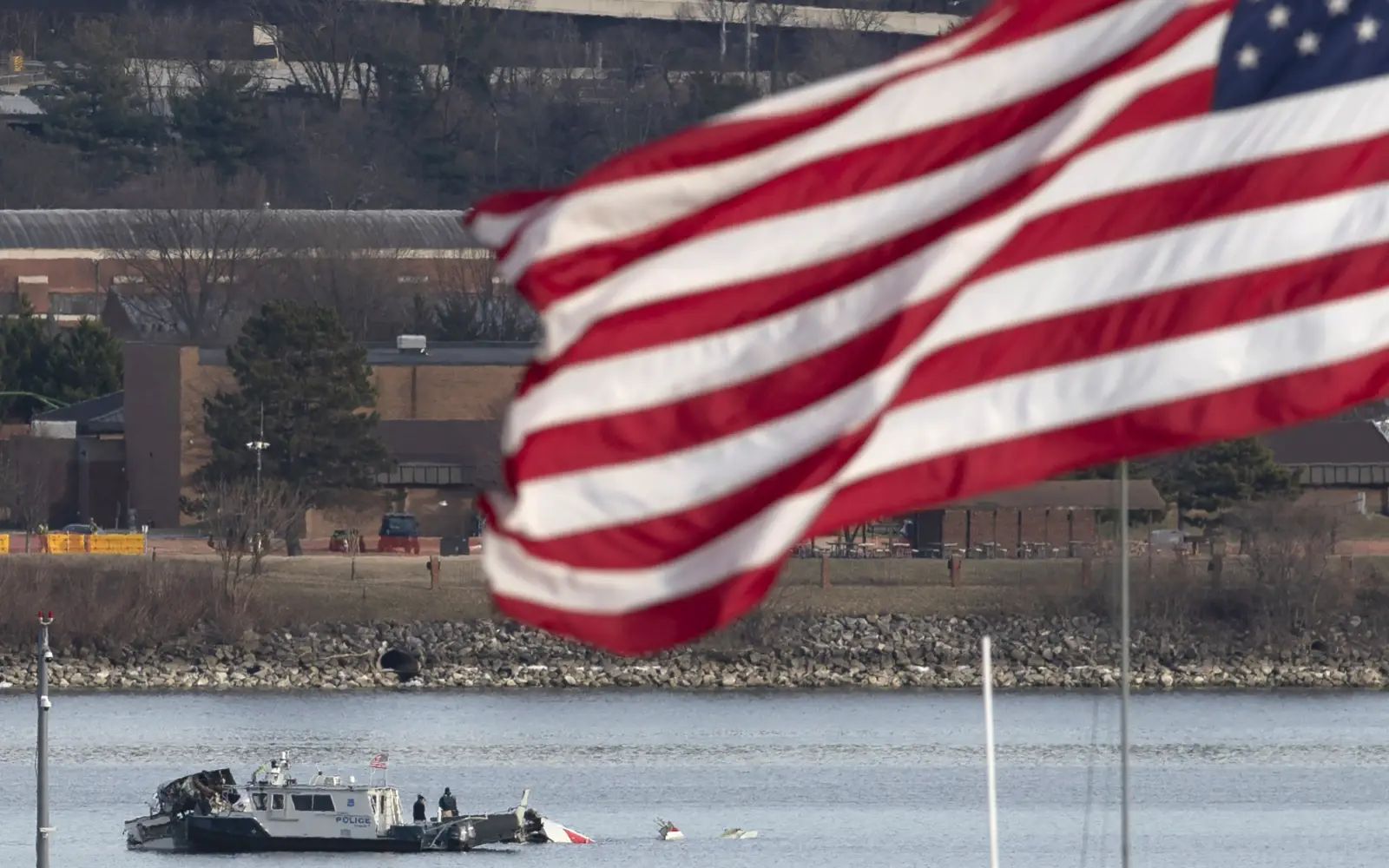
Washington, D.C. — A catastrophic mid-air collision between a commercial passenger jet and a U.S. Army helicopter has claimed dozens of lives near Washington, D.C., sending shockwaves through the nation’s capital. The devastating accident occurred Wednesday evening over the Potomac River, just miles from Reagan National Airport.
Collision Over the Potomac: What We Know So Far
At approximately 8:47 p.m. Eastern Time, an American Eagle regional jet, Flight 5342, operated by PSA Airlines, was on its final approach to Reagan National Airport when it collided with a U.S. Army Sikorsky H-60 Black Hawk helicopter. The helicopter, assigned to B Company, 12th Aviation Battalion at Fort Belvoir, Virginia, was conducting a routine training flight with three soldiers aboard.
Authorities say the aircraft crashed into the Potomac River in a fiery explosion that was captured on a livestream camera. Witnesses described a “massive fireball” illuminating the night sky before debris plunged into the cold waters below.
Search and Recovery: No Survivors Found
Emergency teams rushed to the scene, but hopes of finding survivors quickly faded. D.C. Fire and EMS Chief John Donnelly confirmed late Wednesday that there were no survivors among the 67 people on board the two aircraft. As of Thursday evening, at least 40 bodies had been recovered, with search efforts continuing under challenging weather conditions.
The wreckage of the American Eagle jet was found in shallow waters, broken into multiple sections. The Black Hawk helicopter was discovered mostly intact but flipped upside down in the river. Search crews have recovered both the flight data recorder and cockpit voice recorder, which are now in the hands of federal investigators.
Did Air Traffic Control Play a Role? NTSB Investigates
The National Transportation Safety Board (NTSB) has launched a full investigation into the cause of the crash, with early scrutiny focusing on air traffic control staffing at the time of the incident.
Preliminary reports suggest that only one controller was on duty, handling both helicopter and plane traffic—an assignment typically divided between two personnel. While this practice is not unprecedented, the NTSB will investigate whether the lack of additional oversight contributed to the disaster.
Victims Include Prominent Figure Skaters and Community Leaders
Among the passengers on Flight 5342 were several high-profile figure skaters from Russia and the United States, including six individuals affiliated with the Skating Club of Boston. The victims included:
- Jinna Han (18) and Spencer Lane (21), promising young figure skaters
- Their mothers, Jin Han and Christine Lane
- Former world champions Vadim Naumov and Evgenia Shishkova, who were also the young skaters’ coaches
Spencer Lane’s father, devastated by the loss, described his son as a “force of nature” in the figure skating world, having made remarkable progress in just a few years.
Other confirmed victims include Asra Hussain Raza, a business consultant returning from a work trip, and four members of a Maryland-based labor union. The crew chief of the Black Hawk helicopter, identified as 29-year-old Ryan O’Hara, also perished in the collision.
Political Reactions and National Shock
The tragedy has prompted a wave of reactions from political leaders. President Trump, speaking Thursday morning, confirmed there were no survivors and offered condolences to the victims’ families. However, he also took the opportunity to criticize the Biden administration, though he did not provide specifics linking the crash to any particular policy.
Senator Tim Kaine (D-VA) called the crash “an unimaginable tragedy” and emphasized the need for a thorough investigation. “There are a lot of questions that need answers,” Kaine said.
A Rare Air Disaster in U.S. History
This marks the first major U.S. commercial air crash in nearly 16 years, making it one of the deadliest aviation incidents in recent history. The last comparable tragedy occurred in November 2001 when American Airlines Flight 587 crashed near JFK International Airport.
Aviation experts say that while mid-air collisions are rare due to stringent air traffic control regulations, the proximity of military and civilian air traffic near major hubs like Reagan National Airport presents unique risks.
What Happens Next? The Road to Answers
The NTSB investigation will focus on multiple factors, including:
✔️ Possible air traffic control miscommunication
✔️ Aircraft transponder data and radar records
✔️ Whether flight paths were adequately deconflicted
✔️ Weather conditions and pilot communications
The final report could take months, if not longer, but authorities hope to identify immediate safety improvements to prevent future disasters.
As the nation mourns, families of the victims are left grappling with an unfathomable loss. The Potomac River, a symbol of history and resilience, now bears witness to another heartbreaking chapter.
Read More
How Much Does It Cost to Lease an Airbus A320 Aircraft?
NASA’s Bold Move: Unveiling a Space Sustainability Strategy to Tackle Orbital Debris

